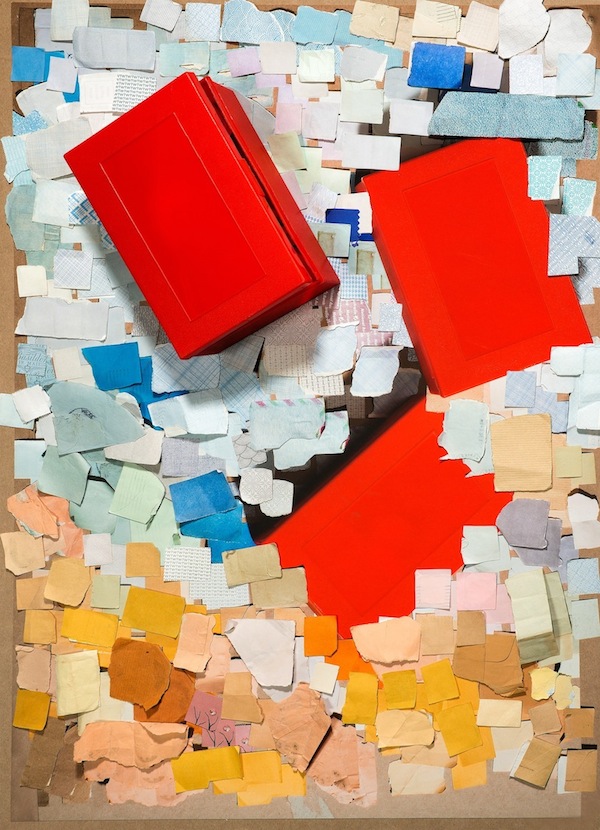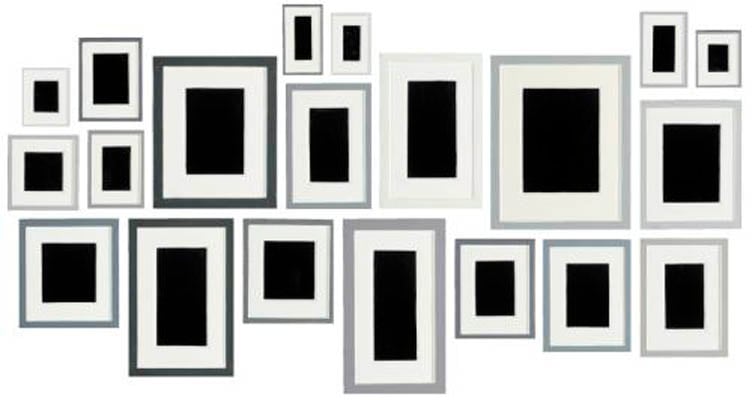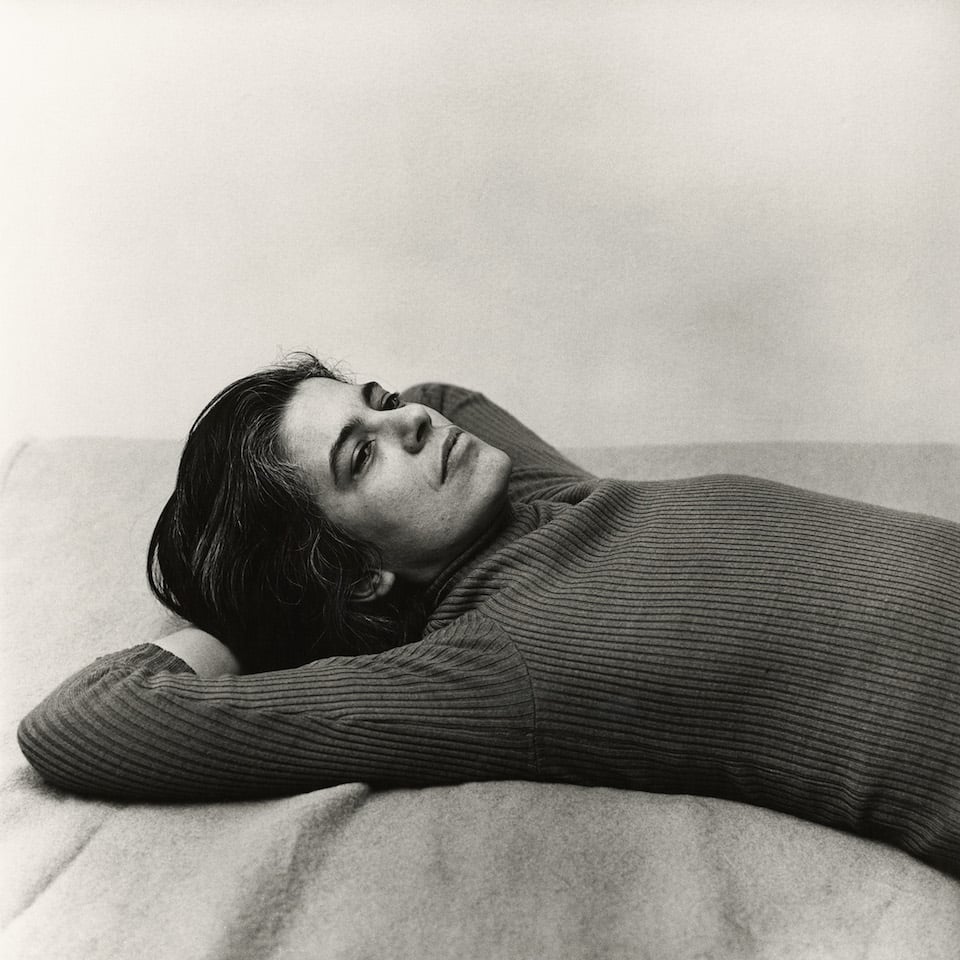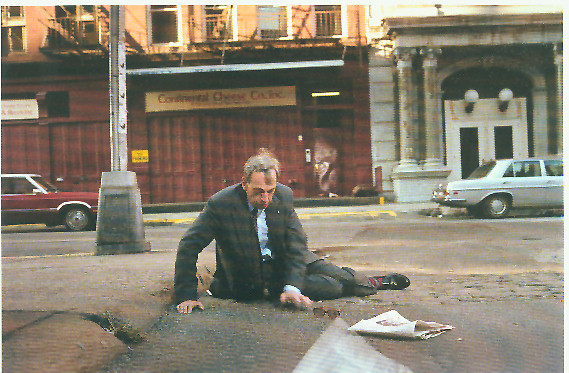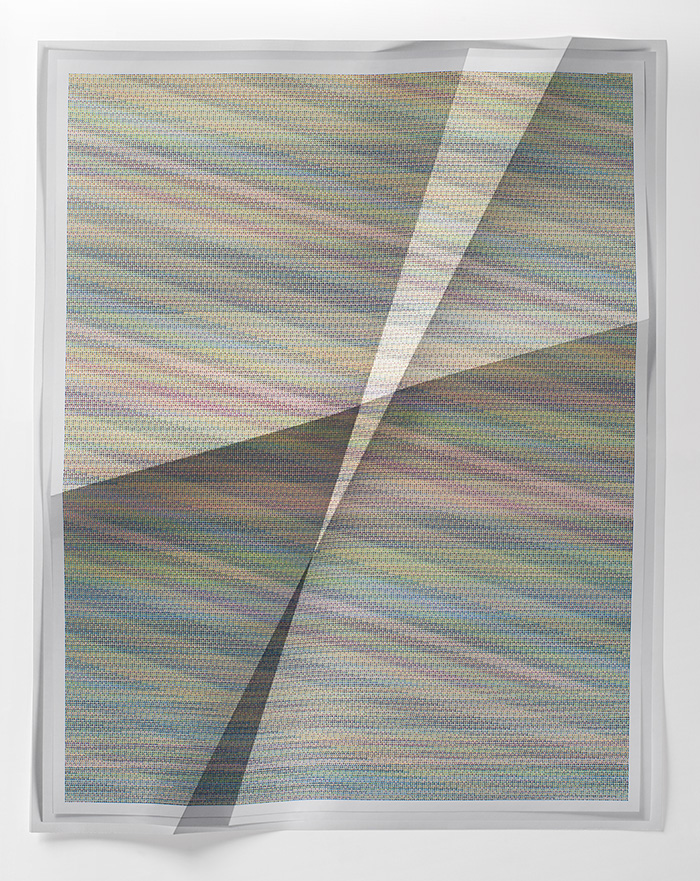
© » KADIST
Abraham Oghobase
This series of photographs is inspired by the artist’s travels to Jos, Nigeria. Having grown up in the urban environment of Lagos, Abraham Oghobase was struck by the tin-mining deposits and the man-made ponds and lakes that form a dominant part of the landscape in the city of Jos and its surroundings. While visually striking, the landscape also holds a complex history, excavated by the artist, who researched the prevalent mining of tin deposits that dates back to 1904 during the British colonial mineral exploration in the Northern Protectorate.

© » KADIST
Abraham Oghobase
This series of photographs is inspired by the artist’s travels to Jos, Nigeria. Having grown up in the urban environment of Lagos, Abraham Oghobase was struck by the tin-mining deposits and the man-made ponds and lakes that form a dominant part of the landscape in the city of Jos and its surroundings. While visually striking, the landscape also holds a complex history, excavated by the artist, who researched the prevalent mining of tin deposits that dates back to 1904 during the British colonial mineral exploration in the Northern Protectorate.

© » KADIST
Abraham Oghobase
This series of photographs is inspired by the artist’s travels to Jos, Nigeria. Having grown up in the urban environment of Lagos, Abraham Oghobase was struck by the tin-mining deposits and the man-made ponds and lakes that form a dominant part of the landscape in the city of Jos and its surroundings. While visually striking, the landscape also holds a complex history, excavated by the artist, who researched the prevalent mining of tin deposits that dates back to 1904 during the British colonial mineral exploration in the Northern Protectorate.

© » KADIST
Awol Erizku
Awol Erizku’s image Origin of Afro-Esotericism has compositional force and a rhythmic use of full-blast color. In the image are five faces each with varying modes of representation. One of them is “Aunt Jemima” (recently renamed Pearl Milling Company), a brand that appropriated a character from a late 19th century minstrel show.

© » KADIST
Carlos Motta
Searching for We’wha is composed of five photographic triptychs combining photographs from the American West (New Mexico and Arizona) with excerpts from American Indian poetry in an attempt to reconstruct imaginary aspects of the life of We’Wha, a famous member of the Zuni tribe, who was born male but who lived a feminine gender expression. With this work, Carlos Motta aims to question gender fluidity, indeterminacy, neutrality and non-conformity, using We’wha as an image of the ways in which Two-Spirit American Indians express gender in non-Western non-traditional ways. They are often accepted and revered by their tribes, and in We’wha’s case she even became an official representative of their social interests.

© » KADIST
Leung Chi Wo and Wong Sara
Office Lady with a Red Umbrella restages a figure from a 1980 postcard made from a photograph from 1950’s. The retro-glamor of the 1950s style is restyled devoid of the original context of a Hong Kong street scene, where the “office lady” is walking on Queens Road of the Central district. With the “office lady” facing away from the viewer with a bare background, an introspective tone is created in Leung’s restaging while highlighting the red umbrella resonating with a red pencil skirt emblematic of the identity of the professional urban woman when Hong Kong was under British rule.

© » KADIST
David Haxton
16 films is a selection of David Haxton’s single-screen videos, which he began producing in the 1970s as a continuation of some of the conceptual underpinnings of his earlier film installations. As the described by Haxton, “[he] became interested in in examining the nature of the medium [of film] including light, movement, and the formation of a three-dimensional illusion of space in a flat surface.” This selection of films were produced in 16mm film between 1970 and 1982 and have been digitally mastered in high definition from the original 16mm films, which are preserved by the Academy Film Archive in Los Angeles. Reminiscent of the paired back, low-fi quality of other conceptual video work from that period, Haxton abides to a certain criteria to restrict aspects of the medium: he does not do any editing, always fixes the camera onto a single position for the whole duration of the films, and he limits the actions of the performers.

© » KADIST
Carter Mull
Mull’s Worker’s Clock collage works bring together images from the artist’s studio photography practice, found photographs, and pages from a phone book, laying them over a psychedelic warp of color in the background. One of the images is borrowed from a billboard, Double Block (for Alanna Pearl, Nik Nova and R. Mutt) (2013) that Mull created to hang above some storefronts in downtown Los Angeles. The pair of photographs features a woman posed in the center for rings of numbers, her body and shadow taking the place of the mechanical hands.

© » KADIST
Malick Sidibé
Au bord du Fleuve Niger (1976) offers a unique insight into the lives of the 1970s in Bamako. The photograph provides a glimpse into the notoriously active and exciting life alongside the Niger River, where parties would often last until the early hours of the morning. The gaze of the teenage boys who pose for Sidibé bears witness to an intimate space between the lens of the camera, the artist, subjects and the viewer.

© » KADIST
Moe Satt
These photographs document the hand and facial gestures in Moe Satt’s performance F n’ F (Face & Fingers) . Whistling and wearing minimal clothing within a bare gallery space, Moe Satt performed a choreographed sequence of gestures based upon those he observed on the streets of Yangon, Myanmar. Each photograph is simple, showing only the artist’s face and hands with a title and caption that describes the meaning of the documented gesture.

© » KADIST
Reza Aramesh
The photographed plaster heads set against the idyllic landscapes of the south of England, subvert the process of image production and memory. Based on photographic sources from journalism, they have preserved a ‘memento mori’ in the intimate form of a sculpture, yet derived from a source which is not only public but also voyeuristic. They have been entirely dislocated from their original context, and transferred to the realm of photography again, into fragile silver gelatin prints.

© » KADIST
Ana Roldán
Ana Roldán’s Primeval forms series looks up close at the fecund shapes of plants often found in the artist’s native Mexico. These botanical portraits, like this one of the Pseudobombax ellipticum, or shaving brush tree, bristle against the edges of the image’s frame, fecund and wild, familiar yet foreign. Ana Roldán works in diverse media such as performance, sculpture, installations, video and collage.

© » KADIST
Reza Aramesh
The photographed plaster heads set against the idyllic landscapes of the south of England, subvert the process of image production and memory. Based on photographic sources from journalism, they have preserved a ‘memento mori’ in the intimate form of a sculpture, yet derived from a source which is not only public but also voyeuristic. They have been entirely dislocated from their original context, and transferred to the realm of photography again, into fragile silver gelatin prints.

© » KADIST
Yosuke Takeda
Yosuke Takeda gives the viewer brightly colored views, each of which he has searched out and patiently waited for. He gives light a density in the precise moments he captures—a forest’s leaves shimmering in the early morning, a street’s reflective surface radiating color at night, luminous blinds drawn over an apartment window. He achieves his distinctive effects by using an old, second hand analog-era lens that he attaches to his digital camera.

© » KADIST
Jean-Luc Moulène
It rains, Paris, 1st July 2000 , which could be the refrain of a song, is the title of a photograph of a minimal moment, the vision of a Parisian pedestrian, a cut flower lying on the pavement covered in rain drops. Is this moment captured by chance or a mise en scène? There is a sort of hiatus in the image; the planes – motif and background – connect nature in full bloom, pure, fragile, ephemeral with the grey weighty tarmac.

© » KADIST
Abraham Oghobase
This series of photographs is inspired by the artist’s travels to Jos, Nigeria. Having grown up in the urban environment of Lagos, Abraham Oghobase was struck by the tin-mining deposits and the man-made ponds and lakes that form a dominant part of the landscape in the city of Jos and its surroundings. While visually striking, the landscape also holds a complex history, excavated by the artist, who researched the prevalent mining of tin deposits that dates back to 1904 during the British colonial mineral exploration in the Northern Protectorate.

© » KADIST
Rebecca Quaytman
R. H. Quaytman’s family on her father’s side is of Jewish heritage from Poland. In the summer of 2016, Quaytman traveled to Poland to research an upcoming retrospective exhibition taking place in Warsaw and ?ódz, the town from which her great-grandfather emigrated to the United States. Tracing her grandfather’s and great-grandfather’s origins, Phocis Pole is from a series of paintings that explores her paternal lineage.

© » KADIST
Sergio Rojas Chaves
Más vale pájaro en mano que cien volando (A bird in the hand is worth more than two in the bush) is part of a larger series of pieces developed by Sergio Rojas Chaves in Honduras in 2018 that engages with tourism and in particular amateur-ornithologists that overrun the country in pursuit of the nation’s extreme diversity of bird species. The works include a performance in which artist Sergio Rojas Chaves, dressed like a bird, observes the ornithologists as if they too are birds, another work features an audio recording of amateur ornithologists imitating bird sounds in the jungle of Honduras. This series of photographs was taken during an amateur-ornithologist research trip.

© » KADIST
David Haxton
In the mid to late 70s David Haxton turned to photography, and similarly to his output in film, his photographs show reverberations of his perspective as a painter. As inferred from the title—and the titles of most of his work—Haxton has a methodical, near-scientific approach to studying and documenting the effects of light. In Holes in White and Holes in Cream with?

© » KADIST
Jordan Kantor
Lens Flare and the series Untitled Basel Lens Flare (6168, 5950, 7497) were part of a solo project by the artist presented at ArtBasel in 2009. Included in the Kadist Collection, these works continue to explore the ontology of the image to investigate the relationship between painting, photography, and a new time-based variable: film. Reduced here to the essential function of recording the exposure of light through the apparatus of a lens, Kantor then translated these film stills into painted colored canvases that retain the 3:4 aspect ratio of the 16mm film as well as the exact size of the projected image.

© » KADIST
Eileen Quinlan
Eileen Quinlan’s abstracted images, like Swipe , rely on the manipulation of photographic materials inside the studio itself, and reject the exterior world for complex interrogations of the medium.

© » KADIST
Sara Cwynar
Drawing & Print (Drawing & Print)
Sara Cwynar’s composite photographs of found objects and images court feelings of time passing. Using studio sets, collage, and re-photography, she produces intricate tableaux that draw from magazine advertisements, postcards, or catalogs. Cwynar is interested in how design and popular images work on our psyches, in how their visual strategies infiltrate our consciousness.

© » KADIST
Aurélien Froment
dbqp is a photographic series in which the artist handles an enlargement of the plate with three cutout windows which was used for L’Archipel (The Archipelago) in collaboration with Pierre Leguillon. The previous work took the form of four photographs presenting a page illustrated with three images. By studying these with more attention, it is possible to figure out that these objects were placed behind the pierced card with three openings.

© » KADIST
Tsang Eason Ka Wai
New Landmark No. 1 is part of the series New Landmark . In this series, Tsang reversed the direction of his camera lens, and capture images of skyscrapers from an upshot angle.

© » KADIST
Davida Nemeroff
In one series, she considers issues of spectatorship at the Los Angeles Zoo. Box Stall (2013) shows the back end of a horse, highlighting what is included and excluded from the frame of vision.

© » KADIST
Emeka Okereke
Bariga Nights is a photographic series set in the Bariga neighborhood in Lagos (Nigeria). This district has the reputation as home to some of the most disenfranchised of an estimated 21 million inhabitants of Lagos. After several years of being on the road across Africa, Europe and North America, Okereke decided to stay in Lagos in 2016.

© » KADIST
Yosuke Takeda
Yosuke Takeda gives the viewer brightly colored views, each of which he has searched out and patiently waited for. He gives light a density in the precise moments he captures—a forest’s leaves shimmering in the early morning, a street’s reflective surface radiating color at night, luminous blinds drawn over an apartment window. He achieves his distinctive effects by using an old, second hand analog era lens that he attaches to his digital camera.

© » KADIST
Yosuke Takeda
Yosuke Takeda gives the viewer brightly colored views, each of which he has searched out and patiently waited for. He gives light a density in the precise moments he captures—a forest’s leaves shimmering in the early morning, a street’s reflective surface radiating color at night, luminous blinds drawn over an apartment window. He achieves his distinctive effects by using an old, second hand analog-era lens that he attaches to his digital camera.
Abraham Oghobase
Abraham Onoriode Oghobase’s artistic practice explores identity in relation to socio-economic and historic geographies...
Akram Zaatari
- location: Sayda, Al-Lubnan
- year born: 1966
- gender: male
- nationality: Lebanese
Yosuke Takeda
Yosuke Takeda started from experimenting with darkroom photography production and he shifted over to digital photography, aware that photographic film and paper were becoming obsolete...
Catherine Opie
- location: Los Angeles, California
- year born: 1961
- gender: female
- nationality: American
- home town: Sandusky, Ohio
Reza Aramesh
Working across a wide range of materials and processes, Aramesh examines simultaneously the history of Western art and contemporary commentary on the politics and history of the Middle East, concocting a unique visual language to address the contemporary conditions of violence and bio-politics...
David Haxton
Although trained as a painter, David Haxton is known for his exploration of light through the mediums of photography and film...
Rodney Graham
- location: Vancouver, Canada
- year born: 1949
- gender: male
- nationality: Canadian
- home town: Vancouver, Canada
John Houck
- year born: 1977
- gender: male
- nationality: American
- home town: South Dakota
Lucas Blalock
- year born: 1978
- nationality: American
- home town: Asheville, North Carolina
James Welling
- location: New York, New York; Los Angeles, California
- year born: 1951
- gender: male
- nationality: American
- home town: Hartford, Connecticut
Philip-Lorca diCorcia
The works of Philip-Lorca diCorcia oscillate between two possible definitions of photography – from a recording system in the tradition of documentary and a system of representation in the tradition of fiction...
Sarah Conaway
- location: Los Angeles, California
- year born: 1972
- gender: female
- nationality: American
- home town: York, Pennsylvania
Sara Cwynar
Cwyner is both related to a photo conceptual tradition of photography from Vancouver as well as to a new school of photography working with digital manipulation, scanners, stock photography and the notion of photography after image making, both of which are represented in the Kadist collection via artists such as Arabella Campbell, Ron Terada, Tim Lee, Rodney Graham, Ian Wallace from Vancouver and artists such as Chris Wiley, Lucas Blalock, Erin Shirreff or John Houck, who recently have explored the idea of photography beyond image making....
Jason Fulford
Photography and book publishing are inextricable in the work of Jason Fulford...
Andrew Norman Wilson
Andrew Norman Wilson is an artist, curator, and filmmaker whose practice is mostly based in research and documentary...
Carlos Motta
Carlos Motta’s is a multi-disciplinary artist whose work seeks to document the social conditions and political struggles of sexual, gender, and ethnic minority communities through a variety of variety of mediums including video, installation, sculpture, drawing, web-based projects, performance, and symposia...
Allen Ruppersberg
- year born: 1944
- gender: male
- nationality: American
- home town: Cleveland, Ohio
Tsang Eason Ka Wai
Working primarily with photography, but more recently with video and lightboxes, Eason Tsang Ka takes inspiration from the urban density of Hong Kong as well as from everyday objects....
Oscar Munoz
- location: Cali, Colombia
- year born: 1951
- gender: male
- nationality: Colombian
- home town: Popayán, Colombia
Carter Mull
Los Angeles-based artist Carter Mull is an obsessive sort, and his fascinations show through in his multimedia photographic and installation-based works...
Harrell Fletcher
- location: Portland, Oregon
- year born: 1967
- gender: male
- nationality: American
- home town: Santa Maria, California
Awol Erizku
A contemporary response to the historical motif of the still-life, Awol Erizku’s studio photography is brimming with color and symbolism...
Chris Wiley
- location: New York, New York
- year born: 1981
- gender: male
- nationality: British
Elina Brotherus
Elina Brotherus depicts, through her photographic work a portrait of the contemporary artist made during different artistic residencies...
Moe Satt
Moe Satt is a Burmese visual and performance artist who uses his own body as a symbolic field for exploring self, identity, embodiment, and political resistance...
Sadie Benning
When she was fifteen Sadie Benning’s father gave her a kiddie PixelVision camera, a device that recorded grainy black-and-white video on standard audio cassettes...
Eileen Quinlan
Eileen Quinlan makes photographic images through unusual processes, stripping the medium down to its essentials, and working experimentally with light, lenses, chemicals, reflections, and shadows...
Allan McCollum
- year born: 1944
- gender: male
- nationality: American
- home town: Los Angeles, California
Rebecca Quaytman
In her work, Rebecca Quaytman displays great interest in the dissolution of the image...
-
1950-1959
Akram Zaatari
1956“People often asked if they could pose with the Kodak advertisement where a full scale woman is featured with a camera offering Kodak rolls...
-
1960-1969
Akram Zaatari
1966“People often asked if they could pose with the Kodak advertisement where a full scale woman is featured with a camera offering Kodak rolls...
-
1970-1979
David Haxton
197016 films is a selection of David Haxton’s single-screen videos, which he began producing in the 1970s as a continuation of some of the conceptual underpinnings of his earlier film installations...
Akram Zaatari
1970“People often asked if they could pose with the Kodak advertisement where a full scale woman is featured with a camera offering Kodak rolls...
Allen Ruppersberg
1970Untitled (City Limits) is a series of five black-and-white photographs of road signs, specifically the signs demarcating city limits of several small towns in California...
Akram Zaatari
1972“The two men were relatives and both were in the Lebanese Army.” Hashem El Madani...
Peter Hujar
1975Susan Sontag, the author of On Photography and Regarding the Pain of Others, was captured through Hujar’s now-iconic photograph in a relaxed yet pensive pose...
Malick Sidibé
1976Au bord du Fleuve Niger (1976) offers a unique insight into the lives of the 1970s in Bamako...
-
1980-1989
Allan McCollum
1982In the work titled The Glossies (1980), an affinity for photography manifested itself before McCollum actually began to use photography as a medium...
Catherine Opie
1987Catherine Opie’s candid photograph Cathy (bed Self-portrait) (1987) shows the artist atop a bed wearing a negligee and a dildo; the latter is attached to a whip that she holds in her teeth...
-
1990-1999
Rodney Graham
1991Ponderosa Pine IV belongs to a series of large-scale photographs of trees taken by Graham and depicts a particular species that live in Northern California...
Catherine Opie
1994Although best known as a provocateur and portraitist, Opie also photographs landscapes, cityscapes, and architecture...
Rodney Graham
1996Tree on the Former Site of Camera Obscura (1996) belongs to a series of large-scale photographs of trees taken by Graham and depicts a particular species that lives in Northern California...
Collier Schorr
1999Collier Schorr’s prints upend conventions of portrait photography by challenging what it means to “document” a subject...
-
2000-2009
William E. Jones
2000His series, The Golden State, harkens back to his early career and his photographic training...
Jean-Luc Moulène
2004It rains, Paris, 1st July 2000 , which could be the refrain of a song, is the title of a photograph of a minimal moment, the vision of a Parisian pedestrian, a cut flower lying on the pavement covered in rain drops...
David Haxton
2005In the mid to late 70s David Haxton turned to photography, and similarly to his output in film, his photographs show reverberations of his perspective as a painter...
James Welling
2005#17 Pink is a photogram, a photographic image produced without the use of a camera...
Harrell Fletcher
2005The American War , which takes its title from the Vietnamese term for what Americans call the Vietnam War, has toured the United States extensively with the goal of presenting a Vietnamese perspective of that history...
Pascal Shirley
2006Like many of Pascal Shirley’s photographs, Oakland Girls aestheticizes a dingy rooftop and a cloudy sky...
James Welling
2006Welling employs simple materials like crumpled aluminum foil, wrinkled fabric and pastry dough and directly exposes them as photograms, playing with the image in the process of revealing it...
Trisha Donnelly
2007Untitled is a black-and-white photograph of a wave just before it breaks as seen from the distance of an overlook...
Aurélien Froment
2008dbqp is a photographic series in which the artist handles an enlargement of the plate with three cutout windows which was used for L’Archipel (The Archipelago) in collaboration with Pierre Leguillon...
Dinh Q. Lê
2008Hill of Poisonous Trees (three men) (2008) exemplifies the artist’s signature photo-weaving technique, in which he collects diverse found photographs—portraits of anonymous people, stills from blockbuster films, or journalistic images—cuts them into strips, and weaves them into new composition...
Jordan Kantor
2009Lens Flare and the series Untitled Basel Lens Flare (6168, 5950, 7497) were part of a solo project by the artist presented at ArtBasel in 2009...
Oscar Munoz
2009In Ante la imagen (Before the Image, 2009) Muñoz continues to explore the power of a photograph to live up to the memory of a specific person...
-
2010-2019
Leung Chi Wo and Wong Sara
2010Office Lady with a Red Umbrella restages a figure from a 1980 postcard made from a photograph from 1950’s...
Yosuke Takeda
2010Yosuke Takeda gives the viewer brightly colored views, each of which he has searched out and patiently waited for...
Yosuke Takeda
2011Yosuke Takeda gives the viewer brightly colored views, each of which he has searched out and patiently waited for...
Lucas Blalock
2011Compositions such as Tree on Keystone (2011) become hyperreal versions of their real-world equivalents...
Ana Roldán
2012Ana Roldán’s Primeval forms series looks up close at the fecund shapes of plants often found in the artist’s native Mexico...
Chris Wiley
2012Architectural details become abstracted renderings in Chris Wiley’s inkjet prints 11 and 20 (both 2012)...
Carter Mull
2013Mull’s Worker’s Clock collage works bring together images from the artist’s studio photography practice, found photographs, and pages from a phone book, laying them over a psychedelic warp of color in the background...
Lucas Blalock
Drawing & Print
2013(Drawing & Print) Blalock resists the immediacy that we have come to expect from photography—that each photograph should communicate its message without delay...
John Houck
2013Houck’s Peg and John was made as part of a series of photographic works that capture objects from the artist’s childhood...
John Houck
2013Untitled #242 is part of Houck’s Aggregates Series, which uses digital tools to manipulate chosen sets and pairs of colors, creating colorful index sheets, bathed in colors and lines...
Elad Lassry
2013In establishing a deliberate distance between viewer and subject, Lassry raises questions about representation itself and how all portraits are, in effect, fully constructed objects that only gain meaning once we ascribe them with our own personal associations and emotions...
Carlos Motta
2014Searching for We’wha is composed of five photographic triptychs combining photographs from the American West (New Mexico and Arizona) with excerpts from American Indian poetry in an attempt to reconstruct imaginary aspects of the life of We’Wha, a famous member of the Zuni tribe, who was born male but who lived a feminine gender expression...
Yosuke Takeda
2014Yosuke Takeda gives the viewer brightly colored views, each of which he has searched out and patiently waited for...
Sara Cwynar
Drawing & Print
2015(Drawing & Print) Sara Cwynar’s composite photographs of found objects and images court feelings of time passing...
Reza Aramesh
2016The photographed plaster heads set against the idyllic landscapes of the south of England, subvert the process of image production and memory...
Reza Aramesh
2016The photographed plaster heads set against the idyllic landscapes of the south of England, subvert the process of image production and memory...
Eileen Quinlan
2016Eileen Quinlan’s abstracted images, like Swipe , rely on the manipulation of photographic materials inside the studio itself, and reject the exterior world for complex interrogations of the medium....
Sadie Benning
2017In borrowing and subverting images from popular culture, Sadie Benning exposes the media’s role in constructing false and oppressive stereotypes of women, with regard to gender and sexual identity...
Abraham Oghobase
2018This series of photographs is inspired by the artist’s travels to Jos, Nigeria...
Abraham Oghobase
2018This series of photographs is inspired by the artist’s travels to Jos, Nigeria...
Abraham Oghobase
2018This series of photographs is inspired by the artist’s travels to Jos, Nigeria...
Awol Erizku
2018Awol Erizku’s image Origin of Afro-Esotericism has compositional force and a rhythmic use of full-blast color...
Abraham Oghobase
2018This series of photographs is inspired by the artist’s travels to Jos, Nigeria...
Sergio Rojas Chaves
2018Más vale pájaro en mano que cien volando (A bird in the hand is worth more than two in the bush) is part of a larger series of pieces developed by Sergio Rojas Chaves in Honduras in 2018 that engages with tourism and in particular amateur-ornithologists that overrun the country in pursuit of the nation’s extreme diversity of bird species...
Emeka Okereke
2018Bariga Nights is a photographic series set in the Bariga neighborhood in Lagos (Nigeria)...
Andrew Norman Wilson
2019In Andrew Norman Wilson’s work Kodak the artist uses computer-generated imagery to create narratives that question the reliability of images in the age of post-production...





